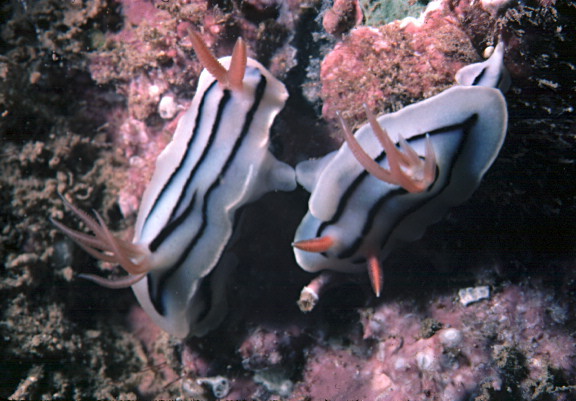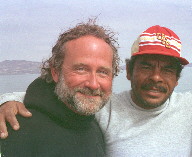
Chromodoris lochi
REPRODUCTIVE BIOLOGY
Traditionally, the Nudibranch of the Week has featured a single species of slug. This week we are presenting photographs of several different species, illustrating various aspects of a single theme--their reproductive biology.
All known opisthobranchs are simultaneous hermaphrodites. They have fully functional male and female organs, producing both egg and sperm. When notaspideans and nudibranchs copulate they must position themselves side by side to align their external genitalia. One faces one direction while the partner faces the opposite direction (see picture of Chromodoris lochi Rudman, 1982, above); in this manner the right sides of their bodies (where the penis and vagina are located) are next to each other, so penetration and passage of sperm can occur.
Sometimes the slugs entwine themselves around each other, like the sacoglossan Plakobranchus ocellatus van Hasselt, 1824. This photo of a copulating pair originally appeared in my and Scott Johnson's book Hawaiian Nudibranchs. Recently the Slug Site's Nudibranch of the Week illustrated the spiny penis of Nembrotha chamberlaini Gosliner & Behrens, 1997. It should be noted that the first published scanning electron micrograph of a nudibranch penis was in the original description of Phidiana lascrucensis Bertsch & Ferreira, 1974.
After copulation, both individuals may be capable of laying eggs. The structure (including form, coloration and size) of the egg mass is often species specific, although we humans can have difficulty recognizing the identity of the slug which laid the eggs. Many times an egg mass is the first clue to a 'Brancher that a slug may lurk nearby. More than once (wow, what an understatement...) I have found specimens of nudibranchs only because I first saw their spawn (see the photograph of the Hawaiian Phestilla lugubris (Bergh, 1870) that we presented in Week 65.
One of the more spectacular egg masses is the 4 cm diameter rose-pink circlet laid by Hexabranchus sanguineus (Ruppell & Leuckart, 1828). This egg mass was photographed at Three Tables, on the North Shore of Oahu, Hawaii.
Also in Hawaiian waters, the dedicated slug hunter can find Glossodoris rufomarginata (Bergh, 1890) and its tightly coiled white egg mass on its preferred black sponge food. These animals were photographed under the Tubastraea Ledge at Pupukea, on Oahu's North Shore.
In the Gulf of California I have observed and photographed the egg masses of numerous species. Most have never been published, certainly not in full color. The Slug Site seems an appropriate (and cost-effective) dispersal mechanism for these images.
Berthellina engeli (Gardiner, 1936), popularly called the Orange Blob, is a common resident of Bahía de los Angeles. Its pale yellow-orange egg mass can be found under rocks in the late winter and early spring.
I have seen the eggs of Chromodoris baumanni Bertsch, 1970, only once. The egg mass was under a rock with several smaller Chromodoris norrisi Farmer, 1963, in a nearby depression. I photographed these eggs at the reef southeast of Hotel Las Arenas, Baja California Sur. This picture was taken on a most memorable dive. My partner Mary Kelley had tried to photograph an octopus that was sitting on top of a huge boulder. She followed it over the side (it didn't want its picture taken), where it crawled into a crevice. While I was occupied rolling the rock under which I found the Chromodoris baumanni egg mass, I happened to glance over at her, as good scuba buddies should do. Low and behold, I watched Mary stick her hand into the crevice, and then immediately (as in quickly, rapidly...) yank it back out. An eel was living in the slot into which the octopus had crawled and bit Mary's hand for her intrusion! Nevertheless, I was able to get the picture of the eggs of Chromodoris baumanni, and my dive partner suffered no permanent injury.
The final egg mass culminating our brief discussion of the reproductive biology of slugs, is that of Bajaeolis bertschi Gosliner & Behrens, 1986. The loosely wrapped, thin spiral is a delicate pink color. I photographed my namesake's eggs (am I a proud papa or what?) at Bahía de los Angeles, Baja California.
There are many scientific papers that discuss the anatomy and behavior of opisthobranch reproduction. The following three references were especially significant in preparing this sixty- ninth Nudibranch "Behavior" of the Week:
Bertsch, Hans. 1987. Sea Slug Sex. Environment Southwest 517: 16-17.
Bertsch, Hans, and Antonio J. Ferreira. 1974. Four new species of nudibranchs from tropical west America. The Veliger 16 (4): 343-353.
Bertsch, Hans and Scott Johnson. 1981. Hawaiian Nudibranchs. Oriental Publ. Co., Honolulu. 112 pp.
Text and photos courtesy of:

Assoc. Prof. |
